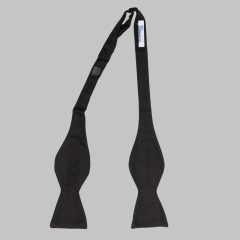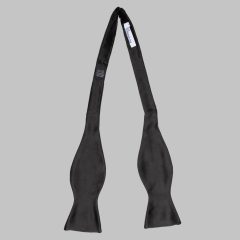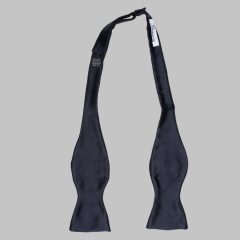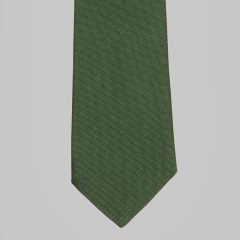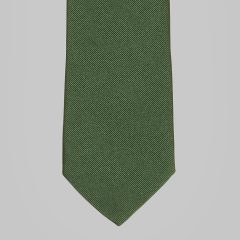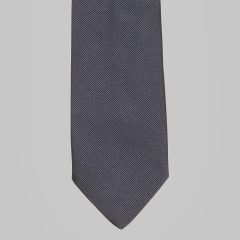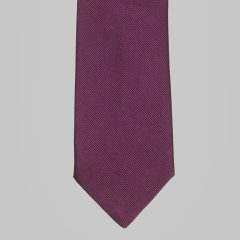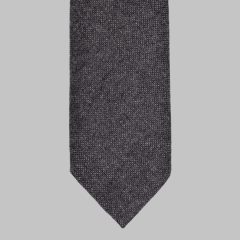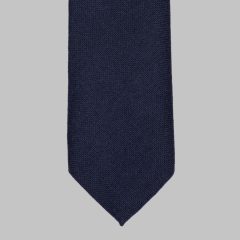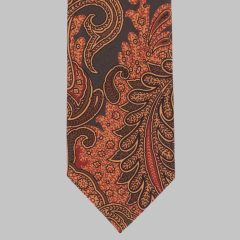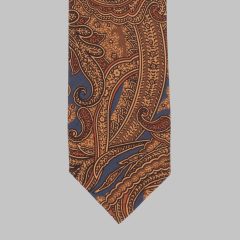Men's Ties
While men’s fashion has a become more relaxed affair in recent years, there are still occasions when wearing a tie is required, and can add that extra touch of sophistication and polish to one's appearance. Formal events, such as weddings, business meetings, and special receptions, often call for the timeless elegance of a well-chosen tie. Job interviews and professional presentations are other situations where a tie can convey a sense of seriousness and attention to detail. However, it's not just about formality – ties can also be a stylish accessory, adding flair to smart-casual looks or making a statement at social gatherings. So, whether it's a special celebration or a professional situation, there are plenty of opportunities to embrace the classic charm of a carefully chosen, well-knotted, tie.
For the origins of the neck tie we have to look back to the 17th century. Between 1618 and 1648 the thirty years war raged, and the french engaged mercenaries from Croatia to fight for them. As part of their uniform they sported neckerchiefs tied to keep their jackets closed. As the war was drawing to a close, and in respect for their service, a number of the Croatian soldiers were presented to King Louis XIV. He was so taken by this new style of neckwear that he not only started wearing them himself, but made them part of the official dress code for royal gatherings. He named this early forerunner of our modern tie “La Cravate” after the Croatians, or Hravats. France was already the leader in European fashion and this new accessory rapidly became popular throughout the continent.
Moving forward to the latter half of 18th century and a piece of military attire, the stock, gets taken up by fashionable London gentlemen. Originally a tight leather neck brace with the twin role of maintaining military poise, and giving some sword protection, it was adapted into a fashion item by Beau Brummell. This arbiter of style,and friend of the Prince Regent, pioneered a less exaggerated style of dressing focusing of the quality, cut and workmanship of a gentleman’s clothes rather than the flamboyant colours and even makeup worn by men at this time. He used a stock of the finest linen, wrapping it around the neck and tying, perfectly it at the front.
As the 19th century progresses so does the industrial revolution. While every aspect of people’s lives changed, the mechanization of textiles production was truly incredible. Products that had previously been incredibly expensive became much more affordable and also varied.
The next step in the evolution of the modern neck tie was the development of the Ascot, named after the royal race course close to Windsor. While this new style started in the mid 1800’s it is still considered the correct necktie at this prestigious, regal, event worn to complete full morning dress and finished off with a top hat. It was at the same time Bow ties began to be seen and became popular among scholars and surgeons and then, curiously, began to be worn with evening attire; white with dress wear and later black with the less formal tuxedos.
It was in 1922, in New York, that a tiemaker named Jesse Langford started making what we can recognise as modern ties. He patented a system cutting the ties on the bias (diagonal) and in three sections making them sturdier and producing a better knot. This quickly became, and still is, the way almost all ties are made. Since then different blade widths and shapes have been developed, as have various internal canvases to give a plumper or sleeker knot, but the basic construction remains the same.
The knots.
Many different ways of tying the new Langford tie were created but three of them are the most commonly seen today. The Four-in-hand, the Windsor and the half Windsor.
The Four-in-hand the simplest,compact, knot that sits well in a semi spread or more closed collars and is also know as the School Boy knot. Because of its simple construction it does tend to be a bit asymmetric.
The Windsor is a impressive, triangular knot that works better with spread collars. Named after the Duke of Windsor this is a more flamboyant style for grand occasions. With its more complex tying it creates a beautiful symmetric knot.
The half Windsor is a slightly simpler version of the Windsor knot. It has less turns and volume, giving a smaller more discrete knot that importantly maintains a symmetrical shape. This again works with semi spread or spread collars and gives a very smart knot without the exaggerated size of the Windsor.
The materials.
While various fibres are used to produce tie fabrics: linen, cotton, wool, alpaca and cashmere, silk has always been the most precious. It has a beautiful touch, is extremely strong and it dyes, or prints extremely well, producing vibrant colours that last well.
The actual fabric structures can be split neatly into three groups. Wovens, where the threads are dyed and then woven to create the pattern. Printed, where the base fabric, almost always silk and usually gum twill is screen printed with the design. And knits where the dyed threads are spun into yarns from which the ties are knitted.
The first group, wovens, is the most complex and are considered by many to be the highest level of design because of the complexity of the patterns that can be achieved.
Different types of wovens were developed in different textile centres. Macclesfield specialised in small geometrics, initially in grey, black and white, giving a marquetry effect across the surface. Another style, like the Macclesfield patterns, that is still popular today are the Spitalfields designs. Originating from the eponymous district of the City of London, French Huguenots had brought their silk weaving skills when the settled there in the 17th century. These patterns distinguished themselves by having slightly larger, and fancier elements containing up to four colours. This technique, being so versatile, became the mainstay of the necktie fabric production and this type of pattern is now produced all over the world.
Grenadine is a classic silk tie fabric using a weaving technique that originated in Italy. It has the texture of a gauze and comes in two structures: garza grossa and garza fina. The garza grossa has a more pronounced texture and a sporty feel while the garza fina has a more delicate surface and is considered more elegant. Grenadine ties can be one colour,striped or even spotted and have been the choice of many menswear icons.
Alongside plain Grenadine there are a number of other fabric weaves that together make up the family of solid neckties. Faille, with it’s ribbed texture, is often used for evening wear ties or bow ties. Satin is also used for evening neckwear, matching the lapels of the evening suit. However, satin ties are also produced in a myriad of colours and can make a bold statement especially when power dressing is the desired effect. Different sizes of herringbone weave both monochrome and with two shades are a popular choice. The other interesting characteristic of the solid tie is that they give a completely different result depending upon the fibre from which they are woven. Refined silk gives the shiniest, most elegant, look. Raw, Shantung, silk created the perfect sporty refined tie. Wool and wool/silk, linen and linen/silk and not forgetting to mention cashmere and cashmere/silk each have their own distinct characters that imbue the tie with a sophistication that, if properly understood, can make a precise sartoriale statement.
Regimental is the name now used for most ties with bold diagonal stripes. As the word suggests they were originally created using the regimental colours and could only be worn by members, or ex-members, of the specific regiment. In the same way universities, sports clubs, colleges and public schools also have unique colour and stripe combinations. Theses were often developed from the striped ribbons or colours of their sports team’s uniforms. Used on the ribbons on the rowing boaters, the stripes of the rugby shirts or the tipping of the cricket jumpers they quickly became, and are still, a sign of social status. This ‘old money’ look was picked up by many designers, Ralph Lauren being a famous example, and is now a staple part of many menswear collections.
Checked, or Tartan ties also have a niche in the hall of historic neckwear, usually woven but occasionally also printed. Due to their Scottish heritage they were originally made of wool and the pattern often related to a specific clan or estate. Slowly the patterns were gentrified and more town appropriate versions were created from silk. This made possible higher colour contrasts and the checked tie gained a three dimensional quality that, when paired with the right shirt and suit, gives a very dynamic look.
Finally, we should discuss prints.
Historically these were always seen as cheaper alternatives to fine woven patterns, and it was not until the early 1920’s that they first appeared, printed onto gum twill, as scarfs. Up until the invention of commercially practical screen printing, around 1907, most fabrics in Europe were printed using intricate wooden blocks, with a separate block for each colour.
After the end of the First World War those affluent enough to afford it spent more and more time holidaying, either by the sea or resorts where other sporting activities could be enjoyed. This created the need for resort clothes and the correct light hearted accessories to complete these new stylish ensembles.
Charvet, the famous Parisian shirts maker, created a revolutionary range of bright, breezy printed neckties that not only captured the frivolous mood, but added a dash of strong colour to the pristine white summer suits that had become so popular.
At the same time the Jazz Age started and colour became all the rage.
After the bold, sophisticated, creations of Charvet it was not until Emilio Pucci in the 1950’s that printed ties were again the centre of attention.
Printing allows an enormous freedom in creating patterns, whether simple dots, complex paisley or even animal or sporting themes, it is only limited by the imagination of the designer and the skill of the engraver and printer.
One of the masters of exceptionally fine, and complex, designs is Hermes. Produced in France they are truly works of art in their precision of printing and colour combinations.
Como, in northern Italy, is probably the largest centre for high quality silk production and printing in Europe. Many tie companies, famous among intenditore including Marinella (from Naples), Petronius 1926 ( from Milan ), Drakes ( from London), Georgina von Etzdorf ( from London) and a host of extraordinary textile designers have there tie fabrics printed in Como.
The most recent revolution in fabric printing has been the introduction of digital printing. This has opened new possibilities and, very importantly, reduced the investment in silk screens or printing cylinders required for printing process ( one for each colour). This has consequently reduced production minimums allowing more patterns to be realized.
Whatever your preference ties from each of the categories we have discussed have a place in a gentleman’s neckwear collection. Each have a distinctive style and can be used to communicate an individual’s personal taste and sophistication. Whatever you wish to say, a carefully chosen tie boldly, or subtly, speaks volumes.





